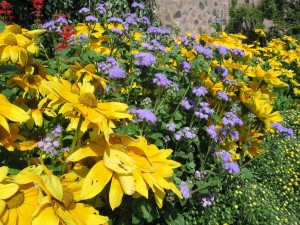Scottsdale’s temperatures may not be in line with the Polar Vortex, but lawn owners and balcony gardeners should still be in the habit of practicing wintertime care of their outdoor plants. Even if a shrub appears healthy through January and February, the effects of freeze damage can show up months after the fact. Don’t despair! Mirabel Golf Club’s Director of Golf Course Operations Jeff Goren shares tips and tricks for keeping your green thumb from being frostbitten by the occasional cold Scottsdale nights and early mornings.

Goren and Mirabel oversee 155,000-square-feet of A-4 Bentgrass greens and a total of 86 acres of irrigated and maintained turf. (Bentgrass is a year-round cool season turf that’s manageable due to Arizona’s cooler summer temperatures and adequate air movement as the Mirabel Golf Club sits 3,000 feet above the Valley, Goren says.)
Scottsdale Living: I see plants covered all over the place in the morning and at night. How do I know when it’s the right time to cover my plants and what’s the proper way to do so?
Jeff Goren: It is important to cover plants to protect them from frost or freeze damage. Damage can occur anytime temperatures start dipping into the 30s – so be sure to cover delicate plants such as poppies and verbena as well as any small bushes or plants in a herb or vegetable garden.
Many succulents or cacti can be susceptible to damage as well. Covering them or placing Styrofoam cups at the top of each arm can prevent damage.
Cover materials should be breathable and home improvement stores, such as Home Depot and Lowe’s, carry good quality frost covers. Of course, old bed sheets also work well. Be sure to avoid plastic coverings as they can trap moisture and damage your plants.
Frost damage occurs when the liquid inside individual cells freeze and form ice crystals. These crystals then rupture the cell walls and damage the cell. Freeze damage typically occurs with lower sustained temperatures and can damage not only leaves, but stems and branches and do much more extensive damage. Freeze damage may not become visible until months after the freeze occurs.
SL: How often should I water my plants during the winter months?
Goren: Not surprisingly, plants require much less water in the winter than summer months. Always water plants so that the soil is saturated but not so much that water is flowing through the yard – or for potted plants, there should not be a considerable amount draining out of container. Water may stain concrete or patios so be sure to have a landscape saucer under any pots.
Allow soil to dry over several days (but do not let the soil completely dry out. You should be able to feel just a little bit of moisture left in the soil. This type of watering will allow for greater root structure and in return a healthier plant.
SL: How do I care for my grass in the winter?
Goren: You’ll need to change up the fertilizer to care for your winter lawn. Winter grass needs more potassium to deal with the stress of cold weather and a good source of iron to maintain a vibrant green color. Your local nursery is a great place to pickup a suitable fertilizer for the cooler months.
SL: Anything else I should know?
Goren: If you do see signs of frost or freeze damage on your plants, resist the urge to remove the damaged pieces. The dead leaves and branches may look bad, but they are actually protecting the still living parts of the plant. Wait until spring to prune.



